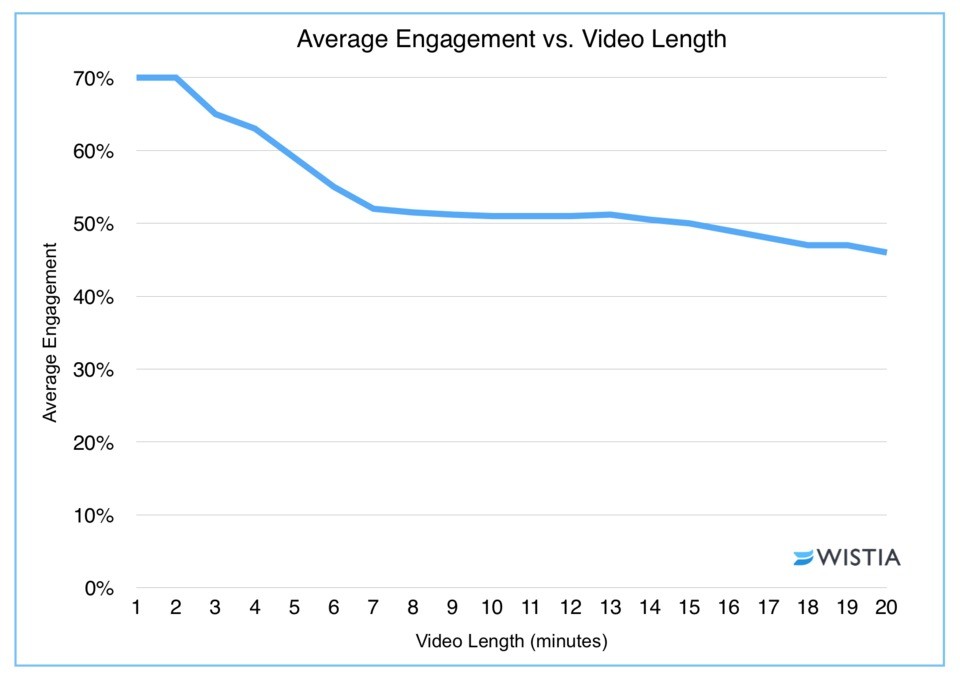When possible, keep the length of the videos you produce to under 2 minutes, or from 6 to 12 minutes for intentionally longer content. Now that you’ve got the TL;DR version, keep reading to find out how we arrived at this decision.
Why did we tell you the main point of this post in the first paragraph? Well, how often do you finish reading an entire article? What’s the likelihood that you’re going to finish this one? We hope the probability is higher than average, but we’re hedging our bets because according to a study by marketing experts, Sumo, they found only 20% of people read articles from start to finish. This made us wonder, if so few people finish the articles they start, how does that translate to video? It’s understood that people are more likely to watch a video than read, so does that mean people are more likely to watch an entire video?
Video length and engagement: let’s look at the data
According to video experts, Wistia, the length of your video has a ton of influence on whether the audience will stick with it or not. When studying viewer engagement in relation to video length, they thought that the trend would look something like Figure 1: not linear, but an array of exponential decay.
Figure 1: Average Viewer Engagement vs. Predicted Video Length
Image sourced from https://wistia.com/learn/marketing/optimal-video-length
However, after studying 564,710 videos and more than 1.3 billion plays, Wistia found that the relationship between average viewer engagement and video length (in minutes) actually looks like Figure 2.
Figure 2: Average Viewer Engagement vs. Actual Video Length
Image sourced from https://wistia.com/learn/marketing/optimal-video-length
As you can see, after 2 minutes there’s a sharp drop in engagement, declining from about 70% to just above 50% between the 6 and 7 minute marks; from there, engagement remains relatively steady with a slower decline until video length reaches 12 minutes, where it again begins to drop more rapidly.
Did we lose you?
So, in other words, videos shorter than 2 minutes have the greatest engagement—this is the ideal length for most videos. Videos between 2 and 6 minutes lose viewers rapidly. Videos longer than 6 minutes, but shorter than 12 minutes, maintain a relatively steady viewership, making this range the ideal length for longer content. After 12 minutes, viewer engagement again begins to decline more rapidly.
When it comes to content, quality matters
Now that you know the importance of video length, there’s one more element to consider: quality. Quality is what hooks your audience and draws engagement. Before you put all your effort into creating videos only of a certain length, consider video quality, too.
That doesn’t mean a quality video needs expensive filming equipment; rather, it means you need to focus on great writing, planning, and execution. By using these 3 elements to create quality videos, you’ll hook your audience earlier, and this means that even if your content needs to be longer than the ideal 2 minutes, you can still boost engagement.
You need to hook your audience in the first few seconds
Whether your video is 2 minutes or 12, the key to boosting engagement is to hook your audience early—if you don’t get to the point quickly, your audience will hit the back button. Though there have been studies that suggest the human attention span has decreased to a mere 8 seconds, the evidence that supports these claims isn’t exactly statistically sound.
Nevertheless, the answer you’re looking for—and what we’d recommend—is to try to hook your audience within the first 8 seconds for social media video content, and within 20 seconds for most other types of video. If you don’t hook your audience by then, you’ve probably lost them. Though it might be tempting to build up to the main point, today’s audience wants you to get to the point right away; after that, you can expand and explain. Now you know why we began this post with the conclusion!
Another way to think about creating a catchy hook early on is to remember how you approached writing research papers in school—the thesis statement needs to be in the first paragraph, followed by the supporting information. As a bonus, when you place the important information first and keep it focused, it’s easier to cut away the excess from your supporting content, allowing you to back up the facts all within a few minutes. Your viewers will thank you for being concise.
4 key takeaways on video length
So, video length, quality, and the hook all play important parts in engagement. But since attention spans are short—you might have even skipped right to this part to see what our full conclusions are—we’ll wrap up with the 4 key tips you should remember next time you produce a video:
- Keep videos shorter than 2 minutes to achieve the most viewer engagement.
- Remember that engagement drops off sharply between 2 and 3 minutes.
- If your content necessitates more time, aim for 6 to 12 minutes.
- Longer videos are more expensive and take more time to make. If you’re producing a video that’s longer than 12 minutes, make sure the content actually requires that amount of time and that it’s really worth the cost.
Pause for a moment and think critically about the videos you’re creating for your marketing, training, and/or sales efforts. Are they 90 seconds, 8 minutes, or a cumbersome 15 minutes? The effectiveness of your content relies on the length and quality of video, and after a certain length, every second counts.


